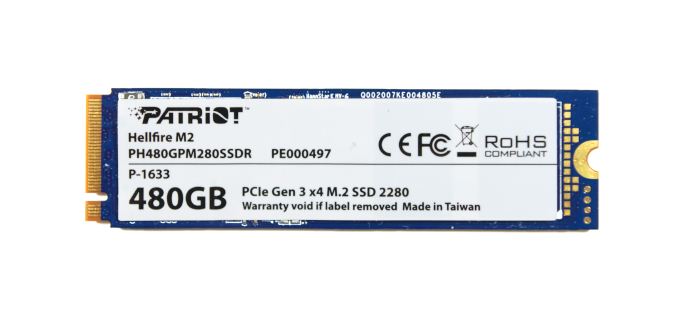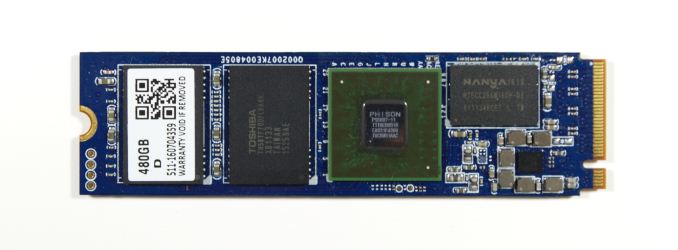The Patriot Hellfire M.2 480GB Review: Phison NVMe Tested
by Billy Tallis on February 10, 2017 8:30 AM EST
The Patriot Hellfire M.2 PCIe SSD is Patriot's first NVMe SSD, and one of several similar products based on Phison's E7 NVMe controller. As usual for Phison, the same drive is manufactured for many of their partners, who typically customize only the branding. Phison designs the controller, firmware, and PCB, but leaves the marketing up to their partners.
Phison's PS5007-E7 controller is their first NVMe SSD controller, supporting a PCIe 3.0 x4 host interface and 8 channels for NAND access. The details we have on the E7 are a bit slim - some collection of ARM cores under the hood is a safe bet, but that's it - however we do know that the E7 controller is manufactured on TSMC's 28nm process and uses FCBGA packaging. Interestingly, it doesn't use the kind of large heatspreader we've seen on competing controllers like Silicon Motion's SM2260. Phison had the E7 platform hardware ready over a year ago, but retail releases were held back by the poor performance of early firmware. Patriot first began shipping the Hellfire last fall, but even after that much delay, they ended up issuing a firmware update shortly after launch.
Phison's controllers are almost always paired with Toshiba's NAND flash, and the Patriot Hellfire uses Toshiba's 15nm MLC. Our review sample is the 480 GB version, the most common capacity for E7 SSD. Patriot also sells a 240 GB version, and some of their competitors offer the 120GB version as well.
| Patriot Hellfire Specifications Comparison | |||
| 240 GB | 480 GB | ||
| Form Factor | M.2 2280 | ||
| Controller | Phison PS5007-E7 | ||
| Interface | NVMe PCIe 3.0 x4 | ||
| DRAM | 256MB DDR3L | 512MB DDR3L | |
| NAND | Toshiba 15nm MLC | ||
| Sequential Read (CDM) | 2740 MB/s | 2550 MB/s | |
| Sequential Write | 1090 MB/s | 1260 MB/s | |
| 4KB Random Read (QD32) | 170k IOPS | 170k IOPS | |
| 4KB Random Write (QD32) | 185k IOPS | 210k IOPS | |
| Warranty | 3 years | ||
| MSRP | $130 (54¢/GB) | $230 (48¢/GB) | |
The Phison E7 controller was originally intended to be a high-end NVMe controller for client or enterprise use. By the time it was ready for the market, Samsung had raised the bar far too high for the E7 to still be considered high-end. But Phison E7-based SSDs like the Patriot Hellfire have been able to offer very attractive pricing and are usually the cheapest MLC-based NVMe SSDs available. Without the pitfalls of TLC-based SSDs like the Intel SSD 600p and the Samsung 960 EVO, the Patriot Hellfire and its relatives have been attractive entry-level PCIe SSD options.
Aside from other Phison E7 SSDs, the closest competition for the Patriot Hellfire is the Plextor M8Pe, based on the same Toshiba 15nm MLC NAND but using the Marvell 88SS1093 controller with Plextor's own firmware. The Patriot Hellfire also has to justify its higher price relative to the Intel SSD 600p, the most affordable NVMe SSD, and against high-performing SATA SSDs like Samsung's 850 EVO and 850 PRO.
| AnandTech 2015 SSD Test System | |
| CPU | Intel Core i7-4770K running at 3.5GHz (Turbo & EIST enabled, C-states disabled) |
| Motherboard | ASUS Z97 Pro (BIOS 2701) |
| Chipset | Intel Z97 |
| Memory | Corsair Vengeance DDR3-1866 2x8GB (9-10-9-27 2T) |
| Graphics | Intel HD Graphics 4600 |
| Desktop Resolution | 1920 x 1200 |
| OS | Windows 8.1 x64 |
- Thanks to Intel for the Core i7-4770K CPU
- Thanks to ASUS for the Z97 Deluxe motherboard
- Thanks to Corsair for the Vengeance 16GB DDR3-1866 DRAM kit, RM750 power supply, Carbide 200R case, and Hydro H60 CPU cooler











43 Comments
View All Comments
KAlmquist - Friday, February 10, 2017 - link
"...a Phison E7 SSD might make sense at the 120 GB capacity point where Samsung has no offering..."IF the performance of the 120 GB version is close to that of the 480 GB drive. It appears that Patriot isn't sending the lower capacity drives out to reviewers. The link given below reports that the 240 GB model providing about 86% of the speed of the 480 GB model. That number may not be terribly meaningful because the reported speeds vary a lot (presumably because some drives were fuller than others when the benchmarks were run), but it seems to be the best data we have. The law of diminishing returns suggests that the performance gap between the 120 and 240 GB models will be greater than the gap between the 240 and 480 GB models. So it seems quite possible that the 120 GB model is a real dog.
http://ssd.userbenchmark.com/SpeedTest/184918/Patr...
HideOut - Friday, February 10, 2017 - link
So why is a supposedly leading tech site doing their review on Windows 8.1? There are already features and such unusable if you don't have 10Ryan Smith - Saturday, February 11, 2017 - link
We're purposely slow to switch OSes so that we can work out the kinks first. Win10 has taken a bit of time to get to place nicely with our SSD tests, though we should be ready to finally roll it out in the next couple of months.HomeworldFound - Sunday, February 12, 2017 - link
That basically means in several years when nobody is reading any more.Billy Tallis - Monday, February 13, 2017 - link
After this review, I have two engineering samples and one retail drive that I'll be reviewing with the 2015 test suite, and then I'll be switching over to the 2017 test suite using Windows 10. If all goes well and if I get enough of the back catalog of drives re-tested with the new suite in time, the WD Black may even get reviewed with the new test suite and the 2015 data will just go into the Bench archives.But you're probably overestimating how important the switch to Windows 10 is for SSD reviews. The Windows 10 NVMe driver still sucks.
leexgx - Tuesday, February 14, 2017 - link
windows 10 provides inconsistent results (unless you disable everything or use windows 10 LTSB and still disable everything) where as you can use windows 8 and have consistent resultsfanofanand - Monday, February 13, 2017 - link
Newegg has a 1 TB Mushkin Reactor for $229.99 today. Until Nvme prices come down (the increase appears to be completely artificial as they are not more expensive to make) I will be on the sidelines enjoying my "slow" Sata 3 SSD.chlamchowder - Monday, February 13, 2017 - link
Interesting how several sites tested this drive, and:-AT criticizes it for being the slowest MLC NVMe SSD and not being price compeitive with the MyDigitalSSD BPX
-Tomshardware also criticized pricing, wrt the 950 Pro (but they also had data on the BPX and showed the Hellfire slightly ahead)
-thessdreview praises it for getting close to the 960 Pro and RD400 while being less expensive
Everyone's probably right at once. From AT's price table, it looks like the Hellfire is a decent PCIe entry at 480 GB. It's cheaper than drives that outperform it while beating the cheaper BPX and 600p.
But I don't think NVMe M.2 drives are worth it right now. They're expensive, power hungry, run hot, and are harder to cool (especially next to a graphics card). I have the M8pe, and it's often hard to feel the difference compared to a good MLC SATA drive. If software changes direction to be far more IO heavy it could be worth it.
ravansranu - Tuesday, February 14, 2017 - link
Ipl T20 2017 is likely to be scheduled to start from April 3rd 2017 to May 26th, 2017. While, opening ceremony and final match of IPL 2017 is to be placed on Eden Gardens, Kolkata.https://iplilive.org
FrogSpawn - Tuesday, February 14, 2017 - link
Perhaps unrelated but what is it with these naming conventions? Hellfire, Bonecrusher, Gravedigger, MurderBox. It's not badass at all, it's ridiculous.